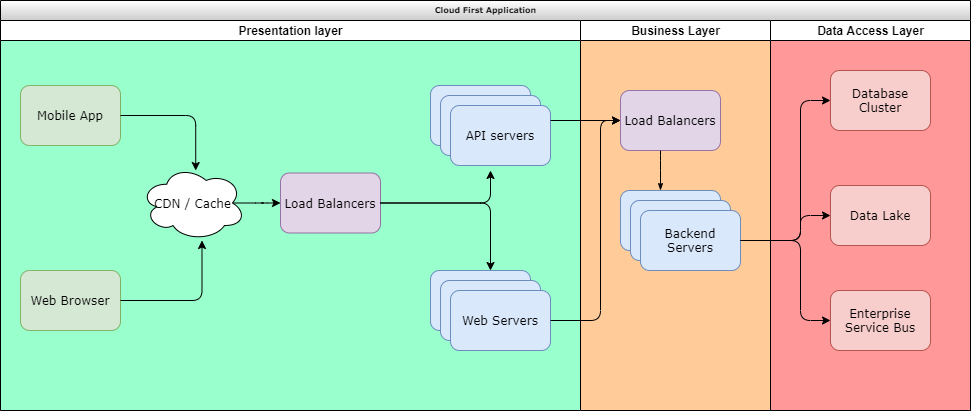What does cloud application architecture look like?
11 April 2021 · Filed in InfrastructureSecure, fast and valuable web applications share a similar architecture. You have a MVP and now need to scale and grow, to profitability.

You should be following the guidance of 12 factor apps for your code base, but what about the platform Hosting your application?
Presentation Layer
Mobile App
If you are developing a mobile first Application, you will have an App on Apple and Android. This may not be the MVP as that can be achieved with web page or simple website. This acts as the main interface your uses have with your service.
Cache
An application needs to be able to scale for your customers and be secure against failure and hackers. This means having a fast caching layer, for quick page loading and protection against dDOS attacks. You can skip this in the early stages of scaling.
Web Frontend
This is the frontend, what the end user sees or perhaps it is the API for a mobile App. It usually serves images, css files, other static content, in addition to html pages, which may be static or dynamically generated. The front end scales depending on how many users are accessing the service at any particular time. Web servers are tuned to serve mostly static content and to scale horizontally quickly.
Business Domain
Business Backend This layer is always behind a firewall and never exposed directly to the internet. To access it, any user is requesting a page from the front layer, and that queries the business layer. This is where the data processing occurs, adding information to the database, retrieving and manipulating data from the database, and scheduled or deferred tasks and jobs are run. This layer is scaled based on peak user times and batch processing. They are usually bigger (scaled up) servers to provide greater computing power. It can be one or many microservices, and the tasks could be configured in docker using ECS or serverless architecture and utilise AWS Lambda.
Database Access Layer
Like the business layer, this is never has direct Internet access. The only thing you want accessing the DAL are business backends. If the Web Frontend (either a layer or a third party, mobile App or API) accesses the database, so can hackers. This is where the all important data is held.
Database
A Database holds persistent information that your application needs in order to provide the service you are offering. It is the product listings, the orders, the customer data. It can be reported on (from the business or report layer) to provide insights to improve or provide KPIs to the business.
Enterprise Service Bus
An Enterprise Service Bus provides links to other data systems within an organisation. This can include other microservices, business backends calling other business backends, Data Lakes, and links to third party APIs hosted by business partners.
Want to find out more?
Please contact me if you want to discuss your platform and how your business can scale to the next level.
Previous Post: Is 12 factor still relevant? Next Post: Platform As A Service? Tags: automation · devops · immutable · ops